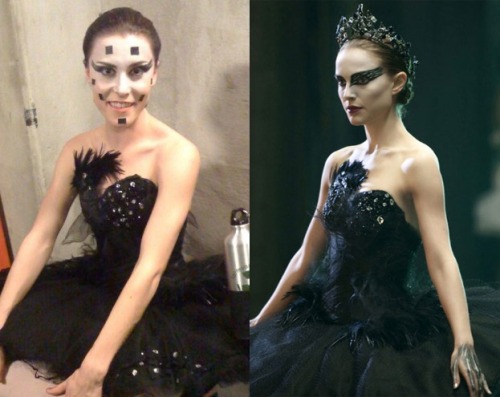It Was Perfect
An analysis of Darren Aronofsky’s Black Swan
The famous Swan Lake ballet tells the story of a girl, Odette, a beautiful maiden cursed to take the form of a swan by the evil sorcerer Rothbart. She and her flock are all doomed to be swans forever, only returning to their human forms under the inky cover of night. They inhabit a pond composed of Odette’s mother’s tears, shed when she lost her daughter to the curse. One day, prince Siegfried happens upon Odette in human form and, learning of her curse which can only be broken by a pure true love, sets about pursuing Odette’s heart. In an evil trick, Rothbart disguises his own daughter, Odile, as Odette and sends her to the Prince’s ball to win his hand. When Siegfried declares his love for Odile, Rothbart’s curse is sealed. No apology from Siegfried can undo his betrayal and, rather than remain a swan for the rest of her life, Odette leaps into the lake, killing herself. Distraught, Siegfried leaps into the lake after her, and Rothbart’s spell is broken by this act of purest love, killing him.
Black Swan opens on a stage where a ballerina dances the prologue of the Swan Lake, in which the wicked Rothbart curses Odette to be a swan forever. When we emerge from this scene, we realize it’s all been a dream, and the dancer was protagonist Nina Sayers, a ballerina with the New York City Ballet. In these first few moments we learn a lot about Nina. She’s old enough to be a professional dancer, yet still lives with her mother. Her bedroom is covered in pink frills and stuffed toys, the bedroom of a child. And, even before she finds out that her company will be performing Swan Lake, she already believes herself to be Odette, the white swan. Nina is tiny and infantilised. Her mother wakes her, feeds and clothes her, and packs her bag to go to work. Her bun is precise, her movements fragile, everything about her clean and coordinated. She is every bit the delicate bird she imagines herself to be.
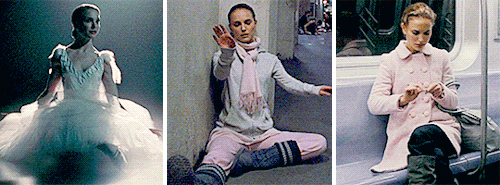
In some ways, Black Swan is a very strange coming-of-age film. Nina is not the typical protagonist of such a story; after all she is 28 and has a successful career. Much has been said, though, by Aronofsky and Natalie Portman both, about the movie telling the story of a woman coming into her own. Smothered by her mother’s doting affections, Nina lived her life stunted. Her mother wanted to be a dancer and had to quit, gave up her career to raise her child, and in turn Nina feels she owes it to her mother to be the perfect ballerina. She lives in the role of the white swan, concerned with her image and how people view her. Do they see the swan? Or the princess she hopes they see? While exploring her dual roles as Odette and Odile, she is berated and molested into confronting her adult self, one settled in her sensuality and unafraid of her appetites. Three women act as role models in Nina’s created image of herself: She is shown who to be and how to be by her mother, she wants to emulate the career of New York City Ballet’s retiring prima ballerina Beth McIntyre, and she looks to fellow dancer Lily as the model for her Black Swan. Nina is forced to grow up extremely quickly to keep the starring role, and in doing so she achieves perfection and fills these three women’s pointe shoes, but she also breaks.
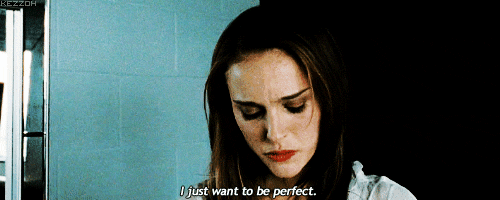
Odette and Odile, the white and black swans, are very obvious stand-ins for “good Nina” and “bad Nina.” Or perhaps they are “child Nina” and “adult Nina.” Repressed, vs. self-actualized. The doubling of women, or division of her “good” and “evil” personas, in the horror genre is a common trope (Deadringer, Persona, Us, Vertigo, 3 Women, Belle Du Jour, Mulholland Drive, Parent Trap…) and is deeply tied to the “Madonna-whore” complex women are societally subjected to. How can one person be morally upright, virginal, virtuous, and responsible, and yet at the same time wild, up-for-anything, untamed, and sexually adventurous? She must juggle two personalities wildly at odds with one another in order to be likable, and yet somehow not fall prey to psychosis. Often the trope sees the evil twin killing the good twin and stealing her life and her hard-earned progress. After all, what is more painful than working so hard to stay virtuous and clean in pursuit of perfection, only to discover your prince prefers a seductive, wilder you?
The moral ever-watchful eye has a strong presence in Black Swan, and yet it not often referenced outright, but rather hinted at by eerie sensation. Everywhere Nina goes mirror reflections return her gaze and people on the street morph into twins of herself, measuring her harshly with their gazes. As in Psycho, the moral eye seems to belong to Nina’s mother, the Mrs. Bates-like ever-watchful, ever-analyzing omniscient presence. Nina has lived under her influence for so long, Mother need not even be present to be imposing her opinion upon Nina. Where mothers, according to Freudian ideology, are the figures with us at our “anal” stage, our first authority figures meant to teach us clean from unclean and help us understand our world, Nina’s mother is a single parent who clings to her daughter as a stand-in for achieving her own dreams. To let Nina go might mean losing the dream, losing all credit for creating and nurturing the Prima Ballerina of New York City Ballet, and might leave her all alone. According to Freud, the harsh or smothering influence of the mother figure during the anal stage fixes the child’s idea of authority, and creates in them an obsession with cleanliness and perfection in order to receive approval. This smothering mother presence likens her to the idea of the Archaic Mother (Barbara Creed, The Monstrous Feminine, Chapter 2). She represents the womb’s inverse desire, to reincorporate its creations into itself by keeping them closer, closer, ever closer.
Nina’s father is never in the picture. Could Father be the wicked sorcerer Rothbart, rendering Nina not only Odette whose mother cries a lakeful of tears at her disappearance, but also Odile, Rothbart’s dark and seductive daughter? In one unnerving scene, Nina wakes up in the morning and begins to try to masturbate, only to be stopped suddenly by the mortifying sight of her mother asleep in a chair by her bed. Her mother is watching her sleep, is making sure she never strays morally from the intended path, is with her even in her dreams. And if Nina tries to rebel against her mother’s influence? The punishment is the revocation of motherly love. In the beginning of the movie, when Nina is cast as the Swan Queen, Mother brings home a beautiful pink cake to congratulate her. As she cuts a slice for her daughter, Nina warns her not to make it so big, she’s got to stay trim for her role. Mother overreacts wildly, and decides to throw the whole thing out, declaring it garbage. Nina can have a heaping portion of mother’s love, far far too much, or she can have none at all. This is the only moment we truly get a hint of the threat Mother must psychologically hold against Nina, but it is enough for us to realize that she is much more controlling than she lets on.
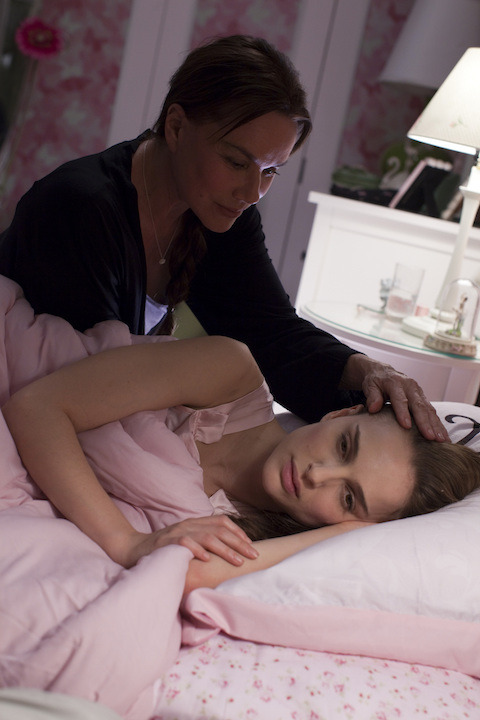
Much has been made of the psychology of this film, with fans and professionals alike coming up with numerous diagnoses for Nina. While she works on a role which demands such breadth from her, she begins seeing doubles of herself. She first experiences this on the subway ride to class in the beginning of the movie, before Swan Lake has even been announced, suggesting Nina is experiencing actual, literal psychosis, and doubling down on the movie’s eerie atmosphere of Nina’s constantly being observed. Later, she sees dark doubles of herself in mirrors, grinning wickedly as they uses Nina’s own hands to hurt herself. Her mother alludes to the chronic nature of the self harm, asking if Nina has been “scratching herself again.” Is she trying to pull out imaginary black feathers? Her mother obsesses over her, and paints hundreds of Nina portraits that all laugh wickedly back at her, mocking the hunger she feels for the perfection her mother wants from her. She is bulimic, or is suggested to be in one early scene which sees her puking up her meager breakfast before auditions. In this film, an eating disorder not only speaks to her obsession with control and perfection, but also to the idea that the “perfect” woman has no appetites, sexual or otherwise. The grandest display of psychosis manifests in Nina’s many hallucinations. She believes that she is sprouting feathers, she believes she sees Beth stab herself in the face repeatedly with a nail file (that Nina stole in an attempt to be “just like her”), she thinks her legs have bent backwards like a swan’s, and she physically manifests her double, her Black Swan Lily, in her bedroom one night. We spend a lot of time wondering what is real and what is imagined, inviting us, the audience, into the creeping uneasiness of Nina’s state of mind. Whether it’s Borderline Personality Disorder, Schizophrenia, OCD, or generalized Hysteria, the point is not to depict a person living with a literal diagnosis, but the symbolic fracturing of a mind attempting to grapple with the demand to become imperfect in order to be perfect in her role.
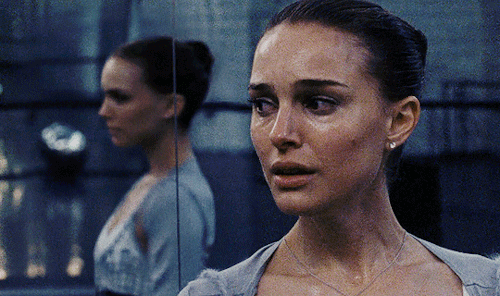
In one part of the movie, the blurred line between reality and hallucination becomes vividly apparent. Lily comes to speak to Nina at her home one night, and wants to take Nina to dinner as a treat. Nina’s mom doesn’t want her to go, as the show goes up the next day and she needs to be well-rested, but Nina goes out anyway. The two go to a bar where Lily orders a “cheeseburger, extra bloody” and has Nina change into a more revealing, dark top more appropriate for the night club atmosphere. While Nina is changing, Lily spikes her drink with ecstacy and reels in two strange men, convincing them to come sit with the girls in their booth. As the night wears on, the effects of the drug become apparent, and Nina and Lily let loose by dancing together and with any of a number of men. Perhaps this is our parallel to the part of Swan Lake where Odile has taken Odette’s form and dances with Siegfried at the ball, convincing him to fall in love with her. Instead of Odile dressing as sweet Odette though, Odette has borrowed Odile’s clothing to feel what it might be like to be her and dance without the pressures of perfection or expectation. Nina comes to as she is making out with a strange man, and runs from the bar. Lily runs out after her and the two take a cab home, where Lily touches Nina.
Only Lily probably never did leave the bar. The next day she claims that she left with one of the men they met that night, and was never with Nina. Which is strange, because Nina distinctly remembers Lily sleeping over. She shut her angry mother out of her bedroom with a makeshift barricade, declared that she wasn’t “fucking twelve years old anymore!” and made love with Lily. Only it wasn’t Lily. The floral tattoo on Lily’s back had morphed into wings, and the Black Swan looked into Nina’s eyes as it smothered her with a pillow. This hallucination is the most important of them all, because not only does it literally blend Lily with Nina’s idea of her Black Swan self, it also insinuates that she was completely alone, the Black Swan inside her the whole time, guiding her in her rebellion against her mother. While a lesbian kiss scene was a cheap and common trope in the early 2000s to put male butts in the seats of movies otherwise intended for women, there is more to this moment than meaningless lusty fodder for viewer’s eyes. When Nina believes Lily is there, she can finally achieve orgasm. Only with the Black Swan’s influence is she able to give way to a side of herself she could never access before. At the end of the scene, the Black Swan smothers the White Swan, and the evil twin is finally able to fully take control of Nina’s life.
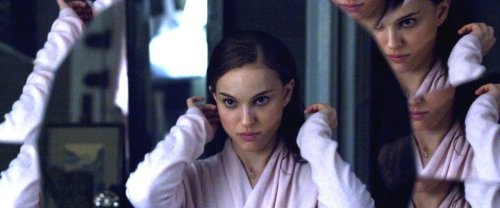
Finally the day of the final performance dawns. Nina is hung over and running late, arriving to find Lily dancing in her role as Odette. Horrified, she descends deeper into madness and experiences such disturbing hallucinations that her mother tries to keep her home and prevent her from dancing on opening night. Indignant, Nina spits back “I am the Swan Queen. You’re the one who never left the corps,” and storms out, ready to perform. This moment of betrayal is key. She has finally thrown off her mother’s doting grasp on her life and realized that she is capable of more than what her mother wants for her. She has now surpassed one of her role models in becoming Prima Ballerina and moved closer to perfection.
Earlier in the film, when she was declared in the debut role of Swan Queen at a gala fundraiser hosted for the ballet, prima ballerina Beth McIntyre was announced to be retiring. Beth was director Thomas’ “Little Princess,” but now Nina is moving in as his Queen. That Beth and Nina look alike is no mistake; in this moment they too are doubles. Beth is the “old model,” Nina the “new,” determined to replace her All About Eve style. In the beginning Nina had stolen Beth’s cosmetics and used them in an attempt to be just like her. Now, it is Beth who envies Nina, and it is Nina who acts in this instance as the Evil Twin, usurping the life of the Good Twin. By the time of the final performance, Nina has bettered two of her three role models.
Though Lily is set up to perform Nina’s role when she arrives at the ballet, Nina’s insistence and confidence impress Thomas enough for him to let her dance the Swan Queen. She applies her makeup and dances the first act of the show, though she seems distracted, frail, and stiff. Indeed she is distracted by a hallucination, causing her partner to drop her mid-lift. Although this occurs, she manages to get back up and dance the rest of the act. Upon returning to her dressing room, she sees Lily applying the Black Swan makeup, ready to take over in her stead if she really isn’t stable enough to dance the show. Furious, Nina watches Lily turn into a wicked version of herself and throws the döppleganger into a mirror, smashing it. She takes a shard of the broken mirror and stabs it sharply into the twin’s abdomen, killing her. Only after the twin dies does Nina realize she has actually killed Lily! If we know anything about freud, we can read this image plainly. Where once Nina’s image of Lily dominated her (sexually), now Nina symbolically penetrates Lily. She is the one in control. In a panic, she hides the corpse in her dressing room and continues to apply her Black Swan makeup.
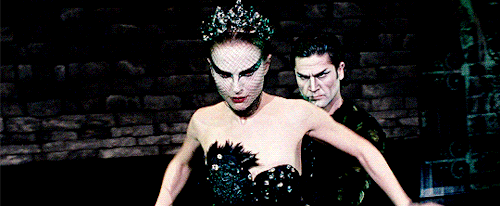
Having bested her last doppelgänger, Nina finally becomes the Black Swan. Now nearly unrecognizable, she comes to the stage with the supreme confidence of a queen. She is beautiful, sensual, sexual, and wild. She dances a perfect performance as the Black Swan, even sprouting wings. Leaving the stage, she surprises Thomas with a passionate kiss and returns to the dressing room to change. There, where she once again changes to perform the White Swan, Lily (alive!) pokes her head in to congratulate Nina on a great performance. But if Lily is alive, who is bleeding out in the dressing room? No one there, and Nina recognizes that she had actually stabbed herself, finding a bleeding hole in her gut. She reaches in an pulls out the horrible shard of mirror. Shaken, but determined, Nina returns to the stage to perform the Final Act, her final act. She climbs the ledge as the White Swan and plummets to her death. And though Nina lands safely on a mattress below, she is still dying of the wound in her stomach. Everyone gathers around her as the red curtain falls, at first congratulatory, and then in a panic. Thomas leans close to her, whispering with concern. Nina looks him in the eyes and says “I felt it. Perfect. It was perfect.” and dies.
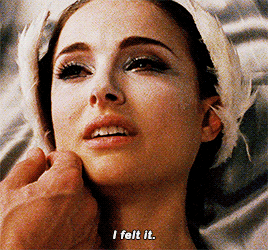
How fascinating that Nina saw this performance as perfect. After all, she fell in the first act, which we would assume for obsessive perfectionist Nina would be a death knell. However, it is not so. The broken, fragile, stiff quality is part of the White Swan’s nature. Perfection is not about a flawless ballet dance, but a flawless embodiment of the character she is portraying. In her performance as the Swan Queen, Nina finally managed to manifest both sides of herself, to use them in tandem and to be, finally, the perfect woman who can somehow embody both Madonna and Whore. However, reaching this goal took so much from her that she died. Whether Nina’s death is literal, or a metaphorical expression of her complete psychotic break, it likely represents the end of her career, the end of her life as she’s known it. If she walks out alive, we cant imagine she walks out sane.
Most importantly, I believe Black Swan represents the sacrifices made by any passionate artist to create their best work. This is a theme seen across much of Aronofsky’s work; To be an artist is to sacrifice everything for the adoration of the fans, for the applause. Nina must give up her relationship with her mother, her sanity, and even her life as an exchange for dancing the perfect dance. It would take an entire separate essay or twelve to delve into the ways in which mother!, The Fighter, The Wrestler, Requiem For A Dream, Pi, and others address this theme, but it seems to be one that weighs heavily on Aronofsky’s mind. To be an artist is to reckon with a curse, a kind of abstract evil, that must manifest to the detriment of all other things. One must give oneself over to the Black Swan.
Addendum
I do find it rather fitting, if not ironic, that Natalie Portman’s dance double Sarah Lane has lashed out, accusing Aronofsky of covering up her contribution to the film. Because ballet takes so much extreme dedication and discipline to perfect, and only a stellar few dancers ever make it to the professional stages of their careers let alone becoming soloists, a professional ballerina had to be brought in to make Portman’s performance more convincing. Sarah Lane is a principal soloist with the American Ballet Theater, and danced many of the full-body or feet-only shots required in the film. She claims that Aronofsky minimized her role as a dancer in the movie, attributing 80% of the final dancing shots to Natalie Portman’s “rigorous training regimen” to prepare to play Nina Sayers. In reality, says Lane, it was she who did 80-90% of the dancing that appears in the final cut, often with Portman’s face digitally imposed over her own. None of the math has truly been settled in this argument, and it seems Aronofsky’s ethics in this case will remain up for debate for the foreseeable future. Lane asserts that Portman was given all of the credit, and Lane’s role was suppressed, so that Portman would have an easier chance at an Oscar win for playing Nina. The irony is that the production of the movie has manifested a real-life example of the doppelgänger takeover. If Sarah Lane is the Good Twin, Natalie Portman is the Evil Twin, literally stealing her identity and putting her name on all of Lane’s accomplishments to become Queen. Who could have anticipated such a cruelly fitting finale to Black Swan.
